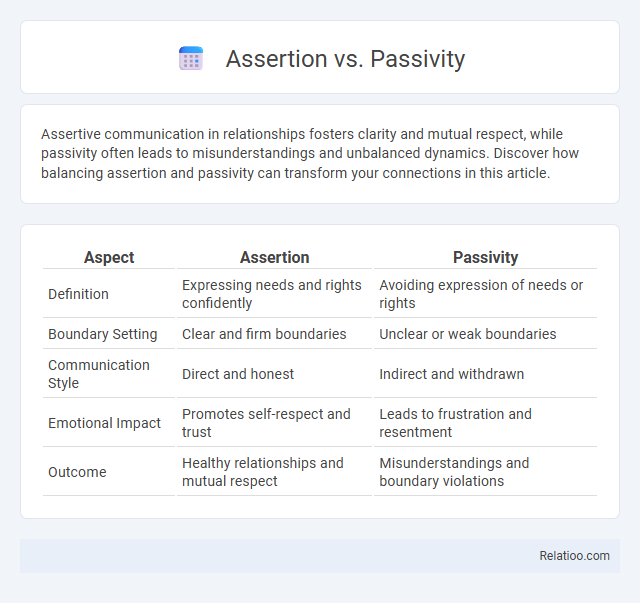Assertive communication in relationships fosters clarity and mutual respect, while passivity often leads to misunderstandings and unbalanced dynamics. Discover how balancing assertion and passivity can transform your connections in this article.
Table of Comparison
| Aspect | Assertion | Passivity |
|---|---|---|
| Definition | Expressing needs and rights confidently | Avoiding expression of needs or rights |
| Boundary Setting | Clear and firm boundaries | Unclear or weak boundaries |
| Communication Style | Direct and honest | Indirect and withdrawn |
| Emotional Impact | Promotes self-respect and trust | Leads to frustration and resentment |
| Outcome | Healthy relationships and mutual respect | Misunderstandings and boundary violations |
Understanding Assertion and Passivity
Understanding assertion involves recognizing your ability to express thoughts and needs confidently while respecting others' rights, which enhances effective communication and self-advocacy. Passivity, by contrast, means refraining from expressing your opinions or desires to avoid conflict, often leading to unmet needs or misunderstandings. Developing your assertion skills promotes clearer boundaries and healthier interpersonal relationships compared to the drawbacks of passive behavior.
Key Characteristics of Assertive Behavior
Assertive behavior is characterized by clear, direct communication that respects both personal rights and the rights of others, enabling individuals to express needs and opinions confidently without aggression or passivity. Key traits include maintaining steady eye contact, using a firm tone of voice, and employing open body language, which collectively promote honest dialogue and effective conflict resolution. Unlike passive or aggressive behaviors, assertiveness supports mutual respect and fosters positive interpersonal relationships by balancing self-expression with empathy.
Signs and Consequences of Passivity
Signs of passivity include reluctance to voice opinions, avoiding decision-making, and consistently yielding to others in group settings. Consequences of such passivity often involve diminished self-esteem, increased stress from unresolved conflicts, and missed opportunities for personal and professional growth. In contrast, assertion promotes clear communication and boundary-setting, leading to enhanced self-confidence and healthier relationships.
Psychological Roots of Assertiveness and Passivity
Assertiveness stems from a psychological foundation of self-confidence and emotional intelligence, enabling individuals to express their needs and boundaries clearly while respecting others. Passivity often arises from fear of conflict, low self-esteem, or learned helplessness, leading to suppressed emotions and unmet needs. Understanding these psychological roots is essential for developing healthy communication patterns and balanced interpersonal interactions.
The Impact on Personal and Professional Relationships
Assertiveness enhances personal and professional relationships by fostering clear communication and mutual respect, while passivity often leads to misunderstandings and unmet needs. Your ability to assert boundaries and express desires confidently builds trust and reduces conflict. Balancing assertiveness without tipping into aggression ensures effective interactions, promoting stronger connections and collaboration.
Assertiveness vs. Aggression: Drawing the Line
Understanding the distinction between assertiveness and aggression is crucial for effective communication and relationship management. Assertiveness allows you to express your thoughts and needs clearly and respectfully, fostering mutual respect and collaboration, while aggression overwhelms others and damages trust. Mastering assertiveness without crossing into aggression empowers your interactions with confidence and empathy.
Benefits of Practicing Assertive Communication
Practicing assertive communication enhances self-confidence by enabling individuals to express their thoughts and feelings clearly and respectfully, reducing misunderstandings and conflicts. Compared to passivity, assertiveness promotes healthier relationships through open dialogue and mutual respect, while avoiding the built-up resentment often associated with passive behavior. This balanced approach fosters personal empowerment and effective problem-solving, critical for both professional and personal growth.
Challenges Faced by Passive Individuals
Passive individuals often struggle with asserting their needs and boundaries, leading to unmet expectations and increased stress. Their tendency to avoid confrontation can cause difficulties in decision-making and self-expression, impacting personal and professional relationships. You may find it challenging to develop confidence and effective communication skills, which are essential for overcoming passivity and fostering assertiveness.
Strategies to Shift from Passivity to Assertion
Shifting from passivity to assertion involves recognizing your rights and expressing your needs clearly and confidently while respecting others. Techniques such as practicing "I" statements, setting clear boundaries, and role-playing assertive communication can enhance your ability to confront situations proactively. Developing assertiveness boosts self-esteem, improves interpersonal relationships, and reduces feelings of frustration caused by unresolved conflicts.
Building Confidence for Assertive Interactions
Assertive communication empowers you to express thoughts and needs clearly while respecting others, fostering mutual understanding and trust. Passive behaviors often lead to unmet needs and diminished self-esteem, hindering effective interaction and personal growth. Building confidence through assertive techniques enhances your ability to set boundaries, negotiate, and engage in productive conversations that support positive outcomes.

Infographic: Assertion vs Passivity
 relatioo.com
relatioo.com